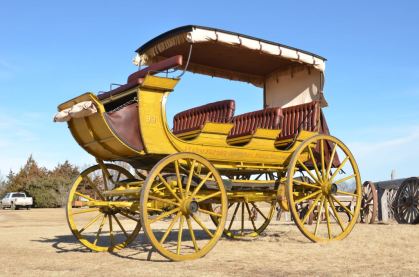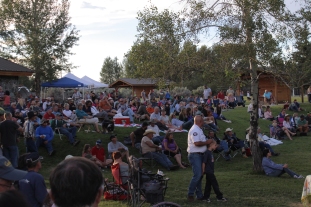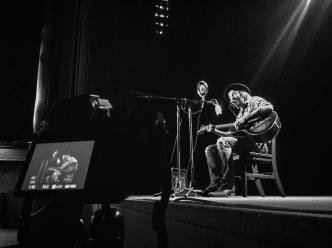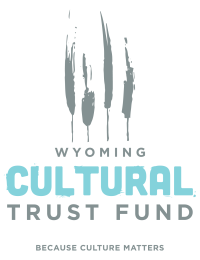This e-newsletter is designed to provide a brief update on the Wyoming Cultural Trust Fund and the happenings of its grant recipients.
It is our promise that this e-newsletter be brief, interesting and hopefully something that will provide you with ideas and contacts with other organizations around the state. If you wish to have your activity highlighted in this e-newsletter, please contact Renée Bovée, WCTF Administrator.
Finding Hidden History — Yellowstone Wagon Conservation Project
 What was expected to be an ordinary restoration project for the Wyoming State Museum turned into a fascinating journey into the history of Yellowstone National Park thanks to assistance from the Wyoming Cultural Trust. In 1970, the museum received an original Abbot-Downing Yellowstone touring wagon. The vehicle had been located in an outdoor shelter near the Laramie train depot for many years. Nothing was known about its history other than it had been used to transport tourists in Yellowstone in the late 1800s/early 1900s. In 2015, museum staff decided to strip the wagon to its bare wood and then have it refinished to the way it would have appeared during its years of use in the park. No one at that time knew the amount of history sealed underneath multiple layers of brown and yellow paint that had covered the wagon for decades.
What was expected to be an ordinary restoration project for the Wyoming State Museum turned into a fascinating journey into the history of Yellowstone National Park thanks to assistance from the Wyoming Cultural Trust. In 1970, the museum received an original Abbot-Downing Yellowstone touring wagon. The vehicle had been located in an outdoor shelter near the Laramie train depot for many years. Nothing was known about its history other than it had been used to transport tourists in Yellowstone in the late 1800s/early 1900s. In 2015, museum staff decided to strip the wagon to its bare wood and then have it refinished to the way it would have appeared during its years of use in the park. No one at that time knew the amount of history sealed underneath multiple layers of brown and yellow paint that had covered the wagon for decades.
The vehicle was sent to a restoration firm with previous experience restoring Yellowstone wagons. Some pieces of the vehicle had been damaged beyond repair or were missing completely, and the original contract was for stripping the wagon, fixing bent or broken parts, and rebuilding parts that had been lost. Shortly after work was underway, the museum received an excited phone call from the restorers stating that test sanding suggested much of the wagon’s original livery, applied at the factory, was still intact under the later layers of paint. At that point, the restoration project changed to became one of conservation and additional funding, much of it courtesy of the Wyoming Cultural Trust, allowed for work on the wagon to be completed by hand, preserving the wealth of historic information dating to its original use in the 1890s.
Abbot-Downing Yellowstone wagons were used to transport tourists through Yellowstone from the early 1890s through 1916. Most of those visiting the park at that time were from the wealthier classes and their expectations were for an adventurous, but very comfortable, experience. After arriving by train at the north entrance of the park near Gardiner, Montana, tourists would journey to Mammoth Hot Springs for a night’s stay then set out on a roughly five-day tour of the park in a Yellowstone wagon with the driver acting as tour guide. Nightly accommodation was at luxury hotels. At the height of the wagon touring era, more than 100 Yellowstone wagons were on the road on any given day. Today, only a handful of the vehicles survive.
As paint was painstakingly removed by hand from the museum’s wagon, more and more detail about the artifact emerged. It was discovered that the wagon was originally designated number “99” of the Yellowstone National Park Transportation Company fleet. It entered service around 1893. The Yellowstone Park Transportation Company took over tourist operations in 1898 and the wagon’s number was changed to “19.” Original, factory-applied details were uncovered such as pin striping on the undercarriage and wheels, the original red, black, and yellow paint scheme of the seat backs, as well as cartouches of the Abbot-Downing company in Concord, New Hampshire where the wagon was built. The wagon’s serial number was found stamped in the metal and painted on the wheels. Also on the wheels were labels to ensure they were placed back on the wagon properly after maintenance. The name of the blacksmith who oversaw the wagon’s original construction was found, and with assistance from the New Hampshire Historical Society a photograph of the man, taken some twenty years after his work on the museum’s wagon, was discovered. Also found were examples of attempts to make the wagon run quieter. Wool packing, held in place with leather, was attached to several of the wagon’s joints in an attempt to dampen noises so they wouldn’t compete with the driver’s voice as he gave his tour of the park. A leather cover to dampen noises from the brake was also still intact. Additional information will most certainly result as these details are investigated further.
It entered service around 1893. The Yellowstone Park Transportation Company took over tourist operations in 1898 and the wagon’s number was changed to “19.” Original, factory-applied details were uncovered such as pin striping on the undercarriage and wheels, the original red, black, and yellow paint scheme of the seat backs, as well as cartouches of the Abbot-Downing company in Concord, New Hampshire where the wagon was built. The wagon’s serial number was found stamped in the metal and painted on the wheels. Also on the wheels were labels to ensure they were placed back on the wagon properly after maintenance. The name of the blacksmith who oversaw the wagon’s original construction was found, and with assistance from the New Hampshire Historical Society a photograph of the man, taken some twenty years after his work on the museum’s wagon, was discovered. Also found were examples of attempts to make the wagon run quieter. Wool packing, held in place with leather, was attached to several of the wagon’s joints in an attempt to dampen noises so they wouldn’t compete with the driver’s voice as he gave his tour of the park. A leather cover to dampen noises from the brake was also still intact. Additional information will most certainly result as these details are investigated further.

This conservation project has resulted in the discovery of much information thought to have been lost to history. It will allow the museum to tell a fuller story of the wagon and its role in the history of Yellowstone National Park to museum visitors. Development of a presentation on this project and the wagon’s history has begun and the museum plans to have the wagon on exhibit in late 2017 or early 2018.
—Jim Allison, Collection Section Supervisor, Wyoming State Museum
WCTF Helps Pinedale’s Soundcheck Series to Keep Rockin’ and Keep Dry
 Ten years ago, The Pinedale Fine Arts Council (PFAC) received a grant from the Wyoming Cultural Trust Fund to purchase sound and light equipment for what would become the Soundcheck Summer Music Series. Funded annually by the Town of Pinedale, the Soundcheck Series features free outdoor concerts all summer long at beautiful American Legion Park in downtown Pinedale.
Ten years ago, The Pinedale Fine Arts Council (PFAC) received a grant from the Wyoming Cultural Trust Fund to purchase sound and light equipment for what would become the Soundcheck Summer Music Series. Funded annually by the Town of Pinedale, the Soundcheck Series features free outdoor concerts all summer long at beautiful American Legion Park in downtown Pinedale.
In its early days the Soundcheck Series presented primarily solo and duo acts but, as interest and attendance grew, the series began to present nationally touring full bands from across the nation.
This past December, in anticipation of Soundcheck’s 10th Anniversary, PFAC applied for and was granted another round of Cultural Trust funding to address the needs of their the ever-expanding outdoor music series.
“In the past ten years we’ve dealt with everything from rain scares to poor lighting to simply not having enough monitors for larger bands,” said Tim Ruland, PFAC’s Marketing/Outreach Director. “The [2007] WCTF grant was an absolute god-send but as we headed in year 10 we really needed to address some logistical issues.”
With their new funding, PFAC purchased three custom rain walls, which can easily be attached to the open stage/gazebo area where performances take place. Once attached the walls can keep the rain safely off the stage and, when the storm clears, can easily be rolled up by a couple volunteers.
“We’ve been so lucky in the past 10 years with weather,” Ruland said. “And while we never had to cancel a show due to rain, we always knew we were completely unprepared for it and really wanted to address for this upcoming summer.”
PFAC also purchased power distribution boxes and cables to more safely and efficiently distribute stage power, which has become all the more important as simple duos and trios evolved into 5 or even 6-piece bands.
Further equipment upgrades included updating to portable LED lighting to replace their clunky PAR CAN setup and purchasing additional stage monitors to accommodate larger bands.
“We were so fortunate that the Wyoming Cultural Trust Fund believed in us 10 years ago to help get Soundcheck off the ground.” Ruland said. “These free outdoor shows have become such a huge part of our community in Pinedale and every year I get more and more inquiries from agents and bands from as far away as Brooklyn and Nashville who want to be a part of the series. We’re really grateful for this year’s additional WCTF support and can’t wait to see where the next 10 years take us!”
such a huge part of our community in Pinedale and every year I get more and more inquiries from agents and bands from as far away as Brooklyn and Nashville who want to be a part of the series. We’re really grateful for this year’s additional WCTF support and can’t wait to see where the next 10 years take us!”
For more information on PFAC’s Soundcheck Summer Music Series visit their website.
—Tim Ruland, Marketing/Outreach Director, Pinedale Fine Arts Council
Wyoming Public Media Goes Beyond Radio
This isn’t your father’s radio anymore! Wyoming Public Media goes beyond radio to engage the minds and ears of listeners, with the help of the Cultural Trust Fund and other sponsors.

People love easily accessible content and the on-demand experience. The podcast and video streaming deliver content immediately and bring new audiences to public media. For years WPM served as a radio chronicler of the Wyoming experience, and we continue this tradition. But as technology evolved, we found ourselves having to take new paths to reach people. We needed to take our rich Wyoming cultural content beyond radio and into the digital sphere where listeners who may not use radio at all can access our product.

HumaNature episode: Dogs Are People, Too
We tested new podcast models like HumaNature and received strong indication of potential and global users. The metrics kept growing, telling us that the “excellent content plus digital delivery” formula can take our western culture productions to a global stage and resonate in a way that radio alone can’t. Since the start of HumaNature in August 2015, we reached over 181,000 streams and downloads. Today, an episode of HumaNature can reach up to 10,000 people.

Next, we asked, “What can we do for Wyoming musicians?” Many artists pass through our studios, including bands like The Black Lillies, The Two Tracks, and Luke Bell. Their artistry should be shared statewide and beyond Wyoming. As a public service organization, WPM should be the connection between artists and our listeners and viewers. Enter the technology of video streaming which can capture both the aural and visual experience and make it available on our website for anyone anywhere in the world to access.
Video has become an integral part of the radio experience and can be found on public radio station websites nationally. WPM already provided video of events, forums, and other activities related to programming and posted this content online. For this project however, we wanted to go beyond our daily video streaming, and produce high quality professional video depictions of bands and artists.
We engaged a professional videographer to create material that has much deeper appeal for the listener/viewer and matches industry standards.
To date we have created 13 videos, featuring bands from Wyoming, the West, and beyond, and a new collection of videos is currently in production and set for release this summer. You can find them on wyomingpublicmedia.org, and on our new website dedicated to “all things Wyoming “– TheModernWest.org.
—Christina Kuzmych, General Manager, Wyoming Public Media
Cultural Trust Fund Board Meeting, Evanston, May 22-23
 The board of the Wyoming Cultural Trust Fund (WCTF) will be meeting in Evanston at the Roundhouse, 1500 Main Street, on Monday, May 22 and Tuesday, May 23, 2017. The board will focus on review and award of April 2017 grant applications. The meeting on May 22 will begin at 9 a.m. and conclude by approximately 4:30 p.m. The meeting on May 23 will begin at 8 a.m. and conclude by approximately 2 p.m. An executive session may be held if needed.
The board of the Wyoming Cultural Trust Fund (WCTF) will be meeting in Evanston at the Roundhouse, 1500 Main Street, on Monday, May 22 and Tuesday, May 23, 2017. The board will focus on review and award of April 2017 grant applications. The meeting on May 22 will begin at 9 a.m. and conclude by approximately 4:30 p.m. The meeting on May 23 will begin at 8 a.m. and conclude by approximately 2 p.m. An executive session may be held if needed.
The Wyoming Cultural Trust Fund meetings are open to the public. Grant applicants are encouraged to attend any grant review meeting, but cannot participate in the proceedings unless addressed by the board. The WCTF administrator and board cannot confirm exactly when a grant application will be reviewed, but the board does have the option of reviewing an application “out of order” if an applicant is present at the meeting for a limited time.
The agenda is posted on the WCTF website, wyoculturaltrust.com Please feel free to contact the WCTF administrator, Renée Bovée at renee.bovee@wyo.gov or by calling 307-777-6312 with any questions.

